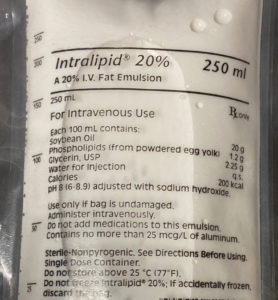


4 Therefore, it is difficult to predict if IVLE will be efficacious for drug-scavenging any particular toxin based solely on log P. However, there is some variability in the reported log P (depending on how it is measured), and the behaviour of the chemical in vivo is affected by its lipophilicity at blood pH, its volume of distribution and other aspects of pharmacokinetics. In general, a log P greater than 1.0 means that a chemical is lipophilic, and above ∼3.0, it is highly lipophilic. The lipophilicity of any chemical is described as its ability to partition into octanol, expressed as the partition coefficient or log P. It is difficult to determine what is lipophilic enough. The toxin needs to be lipophilic enough, however, for it to be attracted to the lipid compartment. In theory, absorption of the drug into an intravascular lipid compartment draws the molecule away from its site of action, giving the body more time to metabolise and excrete the perpetrator. The second proposed mechanism is creation of a drug-scavenging ‘lipid sink’, into which lipophilic drugs or toxins are absorbed. Since this discovery, the use of IVLE for resuscitation of local anaesthetic overdose has become routine in human medicine. It may also increase intracellular myocyte calcium, also assisting positive inotropy. Lipid emulsion is thought to reverse the cardiotoxicity by providing fatty acids to the myocardium and increasing ATP production, thus improving myocardial contractility. 3 Bupivacaine decreases cardiac adenosine triphosphate (ATP) synthesis. 1,2 Since then, infusion of IVLE during resuscitation for bupivacaine has been reported to be successful in multiple human case reports. Initial experimental studies showed improved survival after IVLE in dogs and rats that received a bupivacaine overdose.

The use of IVLE for toxicoses had its beginnings as an antidote for local anaesthetic overdose. In general, it is recommended to stop administering IVLE if the serum/plasma is grossly lipaemic. When considering CRIs, bear in mind that there is no evidence for efficacy of this approach.

However, if using as a continuous-rate infusion (CRI) for more than 1 hour, then attention should be paid to the level of the sterility of the catheter that is used. You do not need a dedicated IV line, as it is delivered over a short period of time. The IV catheter should be checked for patency before starting the infusion, and the catheter should be flushed well after use. It is ideal to consider each bottle to be single-use only. Once the bottle is punctured, it should be discarded within 24 hours due to risk of bacterial growth in the solution. It is traditionally used for providing a fat source in parenteral nutrition formulations but in recent times, certainly in our hospital, it is more frequently used as poison antidote therapy. It is usually provided as a sterile 20% solution of soybean oil, egg phospholipids and glycerine suspended in water. Intravenous lipid emulsion therapy involves injection of a fairly large dose of lipid emulsion over a short period of time in order to counteract the effects of particular toxins. Although there is some evidence for its efficacy in specific toxicoses, its unbridled use in clinical toxicology is still controversial. There has been much interest in the use of intravenous lipid emulsion (IVLE) therapy for many different types of small animal toxicoses in the last 10 years.


 0 kommentar(er)
0 kommentar(er)
